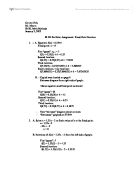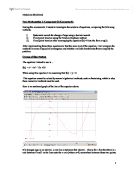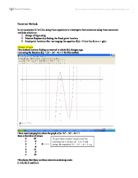9x + 11 – 2x2 = x3
So: 3√ (9x+11-2x2)
Now I will need to create a table to see if my ‘x’ values and g(x) values converge, where they do is the value of a root. Hence the ‘x’ values should be the same as the g(x) values or extremely close. In this case I will quote my answer to 5 s.f. I need to repeat my iterations until x and g(x) is equal to 5 s.f. I will select an arbitrary value for x and call it x0 then from that point onwards; xn+1 = g (xn)
So for example I select x0 to be 3. Then I will calculate my corresponding value for g (x0), my following x value (x1) will be the g (x0) value. Then in the g (x) column for x1 it will be g(x1)
To tabulate my calculations I will use excel. These are the following formulas I had entered into my columns. I had just entered them in the first relevant rows and then dragged it to the end of the table:
So these are the results I achieved when my values converge. Hence a root is found.
The method can be illustrated graphically to show how the method causes the convergence.
By looking at the magnitude of g’(x) at the point of intersection with y = x I can tell whether or not method will work. At this point I see that g(x) line has a gradient of less than 1. The line of y = x will always have a gradient of 1. This is what allows the root to converge. However the gradient of g(x) can lie within a value of ranges for it to be able to converge. Hence -1 < g’(x) < 1. If I was to zoom into the point of intersection: I can see that the gradient of g(x) is below 1 because it is not as steep as y = x at any point through the intersection. Hence the points converge.
The magnitude of g’(x) will affect whether your results will converge or diverge.
Now I will show a case where the rearrangement method fails. I will use the same function.
In this case g(x) = (x3+2x2-11)/9
I will attempt to find the same root as before
Again the generic formula I will use is: xn+1 = g (xn)
From this table I can see that ∆x is continually increasing. This shows that the difference between x and g(x) is getting larger. Hence the values are diverging. From this I can deduce that the root cannot be obtained with this new form of g(x). Again the magnitude of g’(x) is key. If I look at the graph I can see why there is no convergence: This shows that at the point of intersection the gradient of g(x) is greater than the gradient of y = x. since the gradient of y = x is always 1 it means that the gradient of g(x) at the point of intersection is greater than 1. This means that if I was to continue iterating with my calculations I would get diverging values:








